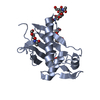+Search query
-Structure paper
| Title | Molecular Mechanism for LAMP1 Recognition by Lassa Virus. |
|---|---|
| Journal, issue, pages | J Virol, Vol. 89, Issue 15, Page 7584-7592, Year 2015 |
| Publish date | May 13, 2015 |
 Authors Authors | Hadas Cohen-Dvashi / Nadav Cohen / Hadar Israeli / Ron Diskin /  |
| PubMed Abstract | Lassa virus is a notorious human pathogen that infects many thousands of people each year in West Africa, causing severe viral hemorrhagic fevers and significant mortality. The surface glycoprotein ...Lassa virus is a notorious human pathogen that infects many thousands of people each year in West Africa, causing severe viral hemorrhagic fevers and significant mortality. The surface glycoprotein of Lassa virus mediates receptor recognition through its GP1 subunit. Here we report the crystal structure of GP1 from Lassa virus, which is the first representative GP1 structure for Old World arenaviruses. We identify a unique triad of histidines that forms a binding site for LAMP1, a known lysosomal protein recently discovered to be a critical receptor for internalized Lassa virus at acidic pH. We demonstrate that mutation of this histidine triad, which is highly conserved among Old World arenaviruses, impairs LAMP1 recognition. Our biochemical and structural data further suggest that GP1 from Lassa virus may undergo irreversible conformational changes that could serve as an immunological decoy mechanism. Together with a variable region that we identify on the surface of GP1, those could be two distinct mechanisms that Lassa virus utilizes to avoid antibody-based immune response. IMPORTANCE: Structural data at atomic resolution for viral proteins is key for understanding their function at the molecular level and can facilitate novel avenues for combating viral infections. Here we used X-ray protein crystallography to decipher the crystal structure of the receptor-binding domain (GP1) from Lassa virus. This is a pathogenic virus that causes significant illness and mortality in West Africa. This structure reveals the overall architecture of GP1 domains from the group of viruses known as the Old World arenaviruses. Using this structural information, we elucidated the mechanisms for pH switch and binding of Lassa virus to LAMP1, a recently identified host receptor that is critical for successful infection. Lastly, our structural analysis suggests two novel immune evasion mechanisms that Lassa virus may utilize to escape antibody-based immune response. |
 External links External links |  J Virol / J Virol /  PubMed:25972533 / PubMed:25972533 /  PubMed Central PubMed Central |
| Methods | X-ray diffraction |
| Resolution | 2.595 Å |
| Structure data |  PDB-4zjf: |
| Chemicals |  ChemComp-NAG:  ChemComp-HOH: |
| Source |
|
 Keywords Keywords |  VIRAL PROTEIN / Arenaviruse / Lassa / VIRAL PROTEIN / Arenaviruse / Lassa /  receptor binding / receptor binding /  glycoprotein glycoprotein |
 Movie
Movie Controller
Controller Structure viewers
Structure viewers About Yorodumi Papers
About Yorodumi Papers




